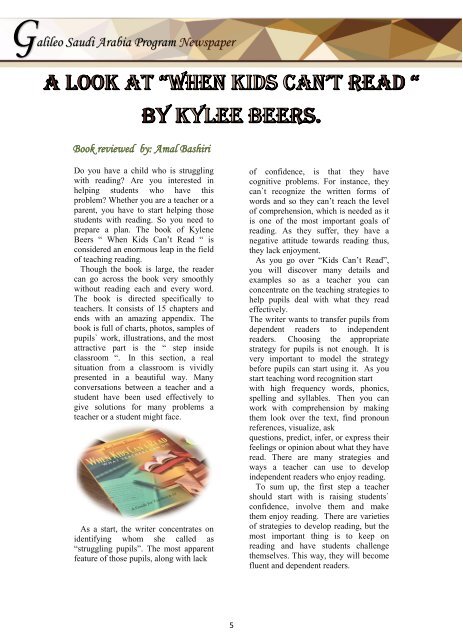Newspaper Khebrat Wave2 Oakland 2018
You also want an ePaper? Increase the reach of your titles
YUMPU automatically turns print PDFs into web optimized ePapers that Google loves.
Galileo Saudi Arabia Program <strong>Newspaper</strong><br />
Book reviewed by: Amal Bashiri<br />
Do you have a child who is struggling<br />
with reading? Are you interested in<br />
helping students who have this<br />
problem? Whether you are a teacher or a<br />
parent, you have to start helping those<br />
students with reading. So you need to<br />
prepare a plan. The book of Kylene<br />
Beers “ When Kids Can’t Read “ is<br />
considered an enormous leap in the field<br />
of teaching reading.<br />
Though the book is large, the reader<br />
can go across the book very smoothly<br />
without reading each and every word.<br />
The book is directed specifically to<br />
teachers. It consists of 15 chapters and<br />
ends with an amazing appendix. The<br />
book is full of charts, photos, samples of<br />
pupils` work, illustrations, and the most<br />
attractive part is the “ step inside<br />
classroom “. In this section, a real<br />
situation from a classroom is vividly<br />
presented in a beautiful way. Many<br />
conversations between a teacher and a<br />
student have been used effectively to<br />
give solutions for many problems a<br />
teacher or a student might face.<br />
As a start, the writer concentrates on<br />
identifying whom she called as<br />
“struggling pupils”. The most apparent<br />
feature of those pupils, along with lack<br />
of confidence, is that they have<br />
cognitive problems. For instance, they<br />
can`t recognize the written forms of<br />
words and so they can’t reach the level<br />
of comprehension, which is needed as it<br />
is one of the most important goals of<br />
reading. As they suffer, they have a<br />
negative attitude towards reading thus,<br />
they lack enjoyment.<br />
As you go over “Kids Can’t Read”,<br />
you will discover many details and<br />
examples so as a teacher you can<br />
concentrate on the teaching strategies to<br />
help pupils deal with what they read<br />
effectively.<br />
The writer wants to transfer pupils from<br />
dependent readers to independent<br />
readers. Choosing the appropriate<br />
strategy for pupils is not enough. It is<br />
very important to model the strategy<br />
before pupils can start using it. As you<br />
start teaching word recognition start<br />
with high frequency words, phonics,<br />
spelling and syllables. Then you can<br />
work with comprehension by making<br />
them look over the text, find pronoun<br />
references, visualize, ask<br />
questions, predict, infer, or express their<br />
feelings or opinion about what they have<br />
read. There are many strategies and<br />
ways a teacher can use to develop<br />
independent readers who enjoy reading.<br />
To sum up, the first step a teacher<br />
should start with is raising students`<br />
confidence, involve them and make<br />
them enjoy reading. There are varieties<br />
of strategies to develop reading, but the<br />
most important thing is to keep on<br />
reading and have students challenge<br />
themselves. This way, they will become<br />
fluent and dependent readers.<br />
5


